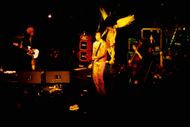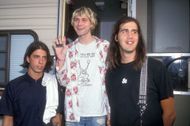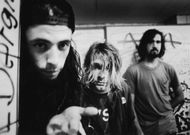Nirvana did not merely make music, they rattled the very fabric of music culture. Born of the Pacific Northwest's underground grunge scene in the late '80s, they possessed a raw intensity and a timelessness of anger that resonated long after their hometown of Seattle.
What distinguished them wasn't the distortion-warbled guitars or the tough-around-the-edges sound; the emotion rested behind each phrase, the stripped bare honesty speaking to a generation of misfits lost in aloneness.
With the hugely introspective Kurt Cobain as its leader, whose music worked to dissolve the line between pain and art, Nirvana never aimed to have its say for an age; it ended up as its accidental vessel.
Spanning from the raw intensity of Bleach, the genre-transcending austerity of Nevermind, and the emotional range of In Utero, Nirvana's records document a band changing yet staying true to itself. Each album is a riff on a theme, raw, refined, and naked, ensuring their legacy well after grunge faded from the pop zeitgeist.
Yet within this giant catalog, which songs have stood the test of time across decades and generations? Which tunes have become something greater than just hits, being cultural reference points that continue to have resonance with listeners all over the world?
Songs such as Lithium, Come As You Are, Heart-Shaped Box, In Bloom, and Drain You are merely a sampling of how Nirvana merged raw emotion with unforgettable melodies. From the bare-bones vulnerability of Polly to the pyrotechnic intensity of Territorial Pissings, each song contributes something new to the band's heritage.
Disclaimer: This article contains the writer's opinion. The reader's discretion is advised!
Here are the top 10 Nirvana songs of all time
These are the Nirvana all-time top 10 songs, a fixed list that reveals the band's lyrically mature depth, audio aggression, and affective resonance. These recordings keep intact the sheer energy propelling them towards stardom and the toned-down, wounded pieces of exposure in which their vulnerabilities lay out there.
From generation-defining opening sequences to otherworldly ballads whose ghostly scream continues to ring out in significance, they are the single best representative of the music of a legacy that will endure by Nirvana. They are teased out by charged forces as overdriven chords, sorrowful harmonies, and raw affective drives, which yet remain their unapproachable standards.
1) About a Girl
Years prior to Nirvana storming the music scene with their grunge-defining, opus-making sound, one of their earliest songs quietly alluded to their wider musical ambitions. Tucked away amidst the sharpness of their 1989 debut album Bleach, About A Girl was notable not for its ferocity but for its restraint, a brief crack of melodic sheen amid the album's violent intensity.
It was penned by Kurt Cobain through an aching relationship, charting a mix of anger and desire in plain-faced, uncomplicatedly straightforward-sounding lyrics. Its flawless guitar and minimalist structure nod towards straight-ahead pop and alt-rock sounds it was referencing while deviating from the distortion so typical of the band's subsequent sound.
Though it might have slipped under the radar on its original release, its acoustic reworking as part of the timeless MTV Unplugged set in 1993 breathed new life into it and showed just how amazingly ageless and emotionally deep Nirvana's songwriting could be.
Read More: Top 10 Cardi B songs that defined her career
2) Heart-Shaped Box
Released as the first single from Nirvana's third studio album, In Utero, Heart-Shaped Box is one of the group's most sound-heavy and emotionally charged recordings. Less a mere story, the song is an enigmatic union of vulnerability and suffering, echoing Kurt Cobain's unease with fame and his own fight with physical and emotional pain.

The sorrowful guitars and piled-up distortion are claustrophobic in feel, for the insistent refrain sung with increasing urgency anchors the unresolved tension of the track. Underlying a layering of symbolic images are references to Cobain's addiction demons, his abusive courtship of Courtney Love, and his chronic illness problems.
The music video, undertaken by Anton Corbijn, took the song's feeling of surreality up a notch with jarring, alien-like visuals, slipping recognition, and sparking controversy along the way. Though disturbing in tone, the song was a commercial success as well as a critical favorite and has remained one of the band's greatest haunting songs and their best-constructed songs.
3) Come as You Are
It's the second single from the album Nevermind. Come as You Are rapidly developed into one of Nirvana's signature tunes, both sound and sight. Its storied guitar riff, said to be stealing its ideas from Killing Joke's Eighties, comes with an eerie, nigh-on-sunken mood that hangs over the recording.
With a chorus that is invitation and threat, and a tight arrangement seesawing between quiet verses and howling bursts, the song teeters between exposed and aggressive.

The lyrics are deliberately obscure, and it's left to the listener on lines such as identity, inclusion, or conflict. The music video that accompanies this song, handled by Kevin Kerslake, replicates the tense mood of the song through dreamlike visions in underwater imagery and omnipresent symbolism such as weapons and dark silhouettes.
This tune was short-listed for the MTV Video Music Awards and peaked at the top of the Billboard Modern Rock chart, making Nirvana more than just a flash, an actual phenomenon.
4) Lithium
Released as the third single from Nevermind, Lithium conveys emotional distress and religious skepticism in the form of a mixture of changing moods and sound opposition. Contrary to taking direct reference to bipolar disorder, the song rather portrays a narrator switching between despair and hope imposed from outside, referring to inner conflict in lines that convey a fragile grip on sanity.
Its title is a discreet nod to the medication used to repair mood swings, and the music itself is an echoing of this tension, undertow, contemplative verses burst into thick, exorcism choruses, marked by Kurt Cobain's repeated "yeah" screams that are at once affirming and empty.
The Kevin Kerslake-directed video switched between live concert footage and stage interference on stage to match the tempo of the song. In 1992, Lithium was released to everyone, reaching its peak at number four on the Billboard Modern Rock Tracks chart and becoming one of Nirvana's classics.
5) Drain You
Drain You was released in 1991 as their standard melodic-dissonant fare, possessing a danceable energy that was loved when initially released and ultimately became a live favorite to play.

Even Kurt Cobain himself was bold enough to say that it was one of his favorites to play, and that says a lot about its raw popularity and power. Lyrically, the song is a foggy condemnation of addiction and obsession with a warm, unsettling atmosphere. The lyrics are a horrific but oddly lovely expression of Cobain's troubled ideas about intimacy.
The angry exterior of the song hides an unsettling condemnation of love, control, and destruction that makes the song somber, multi-faceted. Musically, Drain You is propelled by an insistent rhythm section unloading tension in restrained verses, giving way to frantic, strangling choruses.
The instrumental interlude halfway through, featuring discordant distortion, is a moment of near-psychedelic hysteria before the song lurches back into hook-infested melody.
6) Smells Like Teen Spirit
Arguably the most widely accepted to rank among Nirvana's greatest, Smells Like Teen Spirit was as quickly synonymous with the band's success as it was a summary of the teenage frustration and revolutionary attitude. The riff that borrowed from Boston's More Than a Feeling, followed by Grohl's riveting drum entrance, dissipated into an anthem-like and crazy tune.

The heavy with disillusioned chorus summed up the anger of an entire generation. The lyrics could be described as obtuse, but they're proof of Cobain's anger at society and the music industry.
Written in 1991, the title of the song came from a graffiti spray-painted by a friend on the back of a deodorant billboard. A seemingly otherwise moment would be the inspiration for Cobain to write what he had described as his perfect pop song in the Pixies style.
Released at the end of the same year, its music video, directed by Samuel Bayer, featured frenetic vignettes of suburban high school rebellion, which epitomized the youth culture of the era. The video made MTV a success, breaking the song and Nirvana into mainstream success, reaching number six on the Billboard Hot 100.
7) Where Did You Sleep Last Night
Where Did You Sleep Last Night is a powerful and affecting version of an old folk ballad of the 19th century. The song is one in which a man complains to his mistress of her infidelity, informing her where she slept the previous night.
The minimalist but urgent instrumental arrangement of the song, on acoustic guitar, bass, cello, accordion, and harmonica, is one of tension and heartbreak.
Kurt Cobain's own vocals here are some of his most bare and most unnerving, particularly as the song builds toward its climax on a raw, unearthly scream that still haunts long after the record has ended.
Made famous by blues singer Lead Belly, who recorded several versions of it in the 1940s, the song was Cobain's favorite personal song, so much so that he actually owned one of Lead Belly's original guitars.
Cobain selected it as the sentimental closer to Nirvana's historic 1993 MTV Unplugged performance, explaining that he wanted to close with something very personal to him.
Released in 1994 as a solo album, Where Did You Sleep Last Night climbed to position number five on the Billboard Modern Rock Tracks chart without the benefit of the release of a music video, and the album is marked by being one of the group's spookiest and most beloved recordings.
8) Dumb
Dumb, the fourth and last single from In Utero, is the most personal and emotionally exposed song in the Nirvana catalog. Cobain wrote the song in 1990, and it describes his internal struggle with depression and isolation. The acoustic guitar pattern, topped by muffled cello work by Kera Schaley, gives a hauntingly skeletal backdrop to which Cobain's muffled, detached vocals add a sense of emotional distance.

The repetition and directness of the lyrics are offset by an intense sense of resignation and receptivity. Recorded in 1991 during a live performance and later released as a single in 1994, Dumb was still promoted further with its music video, by Kevin Kerslake, of Nirvana's infamous live show at the now-infamous MTV Unplugged.
Showing up on the soundtrack of the documentary movie Montage of Heck, too, it made sure that it found its place in Cobain's heritage because it also reached number 11 on the Billboard Modern Rock Tracks.
9) In Bloom
Written in 1990, In Bloom captures Kurt Cobain's discomfort with the instant cult status of the group's fans who associated with the music of Nirvana without knowing anything about its context. The song was initially recorded with drummer Chad Channing and later reworked with Dave Grohl for Nevermind. It eventually came out as the album's fourth single.

Its hooky guitar grating and angry rhythm hide a biting critique of mainstream listeners, those who harmonize with gleeful abandon but are deaf to the message beneath. The chorus reeks of irony, anger at being misunderstood that has its origins in his Aberdeen upbringing.
Released in 1992 with a satirical music video mimicking 1960s pop concert performances, the song struck both visually and aurally, gaining praise from critics as well as reaching as high as number five on Billboard's Modern Rock Tracks.
10) All Apologies
Issued as the final single from In Utero, All Apologies is one of Nirvana's most emotionally raw tracks, a song that is as much a gentle surrender as a declaration. Composed by Cobain in 1990 and played live for the first time a year later. Its minimal structure, constructed around lamenting cello, melancholy bassline, and reserved guitar by Cobain, contributes to the song's tenuous, reflective mood.

Rather than grand declarations, the lyrics stay in self-doubt and restrained resignation, referencing Cobain's private distress without ever quite stating it. Its live rendition on MTV Unplugged sucked the song of its energy, giving it a nakedness that made it all the more potent.
Peaking at number one on the Billboard Modern Rock Tracks chart, the song remains an essentially human song in Nirvana's canon, unflinching, intimate, and indelible.
Nirvana's music still has a profound influence outside the decade that it ruled, capturing emotions that remain broadly universal: anger, disillusionment, sorrow, and vulnerability. Their music was more than a generation's soundtrack; it was raw emotion regarding people, unadulterated and drenched in reality.
Shattering through the distortion or whispering on the acoustic guitar, Nirvana spoke the unspoken, transforming pain into verse and rebellion into resonance. Decades later, their music still hits with equal force, bearing witness that true influence does not fade; it endures.
Keep reading SoapCentral for more informative content!
Also Read: 12 songs that capture Doechii’s genre-bending brilliance
